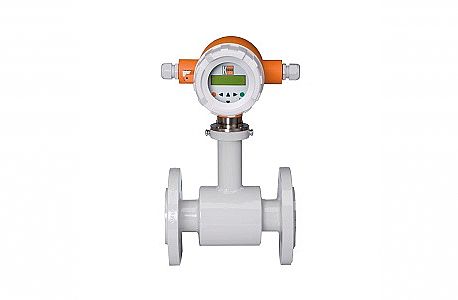מד זרימה מגנטי אינדוקטיבי - EPS תעשייתי
תחומים: m3/h 0.05-40376
דיוק: 0.3% ± מהערך הנמדד
מגוון רחב של ציפוים פנימיים: גומי,PTFE ועוד
אלקטרודה: נירוסטה, הסטלוי, טנטלום, טיטניום
חיבור אוגנים במידות: DN15-300
"ANSI 1/2"-12
יציאה: פולסים ,אנלוגית ,תקשורת HART
אופציה דגם מוגן פיצוץ : EPX/UMF3
0,3 % our standard
HIGHLY ACCURATE – RELIABLE – EASY TO USE
KOBOLD introduces the new electromagnetic flow meter model DMH with a standard accuracy of ± 0.3% of reading stability of zero.
The new developed, microprocessor-controlled converter UMF2 guarantees highest accuracy and is easy to operate via its alphanumeric backlit LCD terminal with 6 keys, plain text response, and plausibility check of your entries.
Empty-pipe detection, coil current monitoring, and plain text error messages guarantee full control over sensor and measuring point at any time. Pulse, status, and current outputs as well as HART® communication are standard features, all of them electrically isolated, of course.
Lining materials such as hard rubber, soft rubber, and PTFE are available, as are Rilsan® and Wagunit®, which are particularly suitable for hygienic areas and water pipes.
As usual, our partner Heinrichs offers a wide range of standard and special electrode materials, including Hastelloy, platinum, and tantalum. To simplify installation, optional grounding electrodes in addition to the grounding flange are available. Cost-conscious customers will appreciate the optional LED status display as an alternative to the alphanumeric LC display
How does a mag flow
meter works?
A mag flow meter operates according to the electromagnetic measurement
principle. According to Faraday’s Law of electromagnetic induction, a voltage
is induced in a conductor moving through a magnetic field. The electrically
conductive medium acts as the moved conductor. The voltage induced in the
medium is proportional to the flow velocity and is therefore a value for the
volumetric flow. The flowing media must have a minimum conductivity.
The induced voltage is picked up by two
sensing electrodes, which are in contact with the medium, and sent to an
amplifier.
The flow rate is calculated based on the cross sectional area of the pipe. The
measurement is independent of the process liquid and its physcial properties
such as density, viscosity and temperature






.jpg)


.jpg)



.jpg)